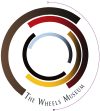By Frank Zoretich
Albuquerque Tribune Reporter
It will be about three years before doors open to the public at the planned New Mexico Exposition Center — including the Wheels transportation museum — in renovated historic buildings where steam locomotives once were repaired in Albuquerque.
That’s the time-to-completion estimate of Franklin Conaway, an Ohio urban redevelopment consultant hired by Wheels and the Urban Council, the private, nonprofit Albuquerque corporations that are cooperatively buying the 27-acre site and its old repair-shop buildings from the Burlington Northern and Santa Fe Railway.
The project will “include a new hotel constructed independently of the center, but in conjunction with it,” Conaway said.
He didn’t say who might own or operate the hotel, how many rooms were being considered or where it might be located in relation to existing buildings “that will require renovation and adaptive reuse” at a cost of about $30 million.
Investment in a hotel and infrastructure improvements by private developers in the overall mixed-use project — including office, retail, and restaurant space — “could raise the ultimate cost of the center to as much as $70 million,” Conaway said.
Although the sale contract has not yet been signed, a railroad spokesman said this week that — after granting Wheels and the Urban Council three months of extensions to secure financing — the railway reversed its decision to sell the property to the other finalist bidder, Dallas developer Stuart A. Jones. When the contract is signed, the Urban Council is to hand the railroad a down payment of $100,000. The rest of purchase price will then be due in 90 days.
In the meantime, Conaway said, he will complete a marketing study for the Urban Council. An environmental analysis will also be completed. “The site looks surprisingly clean, considering the uses to which it was put over the years,” Conaway said. The historic buildings on the property — just south of Downtown on the west side of the railroad’s main tracks — were constructed in 1914 and 1925. They include a total of about 350,000 square feet of floor space. The buildings have been vacant since 1970.
“It’s so unusual for a city the size of Albuquerque to have an opportunity to resurrect what really constitutes a historic village immediately adjacent to Downtown and bring it back to life for the community’s benefit,” Conaway said. “In my opinion, Albuquerque’s opportunity is unique, considering the site’s proximity to the city center and its access to trains and other transportation and its proximity to the airport.”
Conaway said that he and officials of the Urban Council and the Wheels Museum are “anxious to talk to all parties public and private who are interested in renovation of the Downtown area. It’s important that all of the projects now being planned work together harmoniously and that transportation issues are integrated.” A 20 percent federal tax credit on the cost of renovating historic buildings is “a very significant financial incentive” for private developers, Conaway said.
A preliminary market analysis of the property noted that linking the two largest buildings, the old Machine Shop and the old Boiler Shop, “via climate controlled connectors,” would give a combined exhibition space of 210,000 square feet that “should attract large venues that previously could not be accommodated at the existing Albuquerque Convention Center.”
Conaway said he plans to “put together a package for my clients that will detail renovation costs and the amount of square footage available for various projected uses on the site. When that is complete, we will negotiate with developers who have already expressed interest in the project.”
